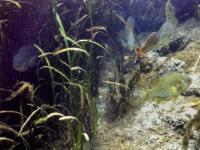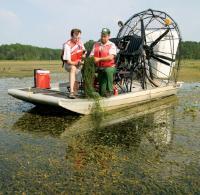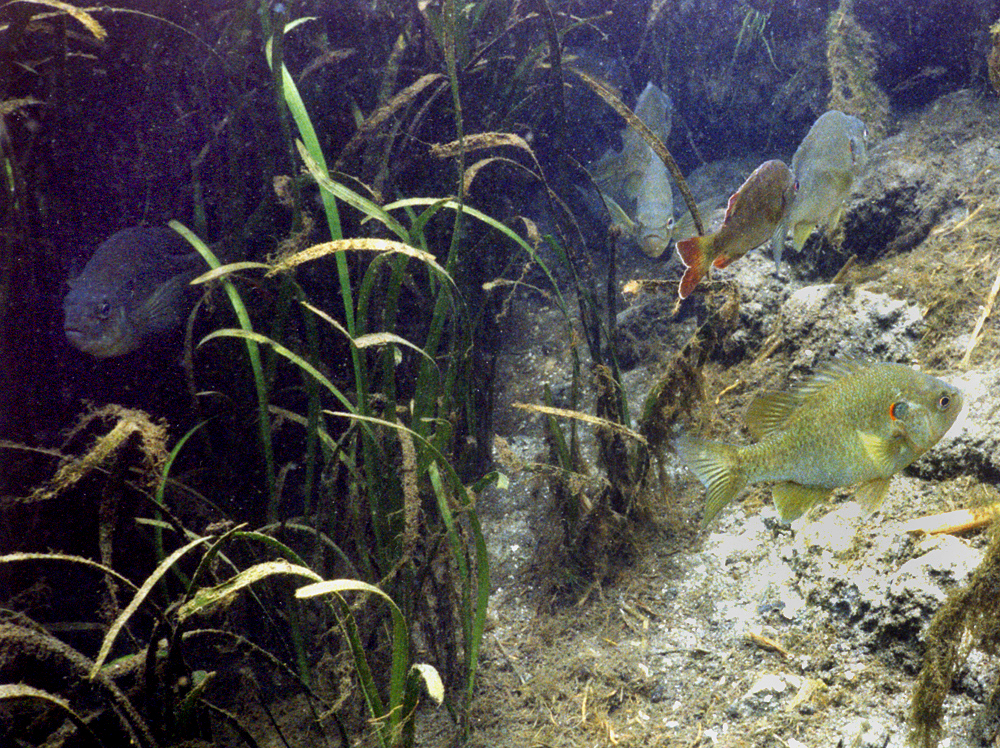Freshwater Fish

Fish use aquatic plants for spawning and nursery areas, as well as for food. Some fish and their fry eat aquatic plants and the algae and small animals that are attached to the stems and leaves. Aquatic plants also offer refuge from predators such as larger fish and water birds.
Submersed aquatic plants also generate oxygen, for fish and other submersed life. But like most environmental factors, balance can be fleeting. Overabundant submersed aquatic plant growth can consume too much oxygen and suffocate fish. One of the worst recorded fish kills in Florida public waters occurred in hydrilla-covered Rodman Reservoir in 1985. Several cloudy days combined with dense hydrilla depleted the oxygen and caused the death of more than 8 million fish in this 10,000 acre reservoir.
Were it not for concerted management of invasive aquatic plants, especially the floating water hyacinth and water lettuce and submersed hydrilla, there wouldn't be much fishing in Florida. When invasive plants infest a lake or river, there are serious declines in the fish population.
It's true that some invasive aquatic plants are beneficial to fish in some ways, especially in the early stages. Just like native plants, invasive plants provide surface area for algae and small animals to live, which provides fish food. Invasive plant infestations also provide structure and cover, allowing young fish to hide from predators.
Native and non-native floating plants can create mats which provide a place where fish are more likely to be caught. Also, vast stands of hydrilla or mats of water hyacinth concentrate fish into smaller areas of open water, increasing the likelihood of a catch.
However, invasive plant infestations also can make it difficult to catch fish. Try dragging a lure through dense hydrilla or tossing a hook into a 10-50 acre mat of water hyacinth. And fisheries research reveals that invasive plant infestations beyond a certain extent actually stunt the growth of fish. There may be more fish in a hydrilla infestation, but they are smaller fish.
Native plants provide the same beneficial functions as invasive plants, and have done so for a longer period of time. For example, eel grass, pondweeds, bladderwort, the submersed Sagittarias, such as awl-leaf arrowhead and other native plants are beneficial to fish, birds, and other animals that evolved with them. Scientists and managers conclude that diverse populations of native plants are better for fish than a dense monoculture of non-native invasive plants.
And native plants seldom fill the water or form masses at the water surface, restricting navigation and recreation, consuming oxygen or creating flood control problems.
Aquatic Plant Management and Fish

Fish use aquatic plants for spawning and nursery areas, as well as for food. Some fish and their fry eat aquatic plants and the algae and small animals that are attached to the stems and leaves. Aquatic plants also offer refuge from predators such as larger fish and water birds.
While plant management activities improve habitat for fish and wildlife, managers are careful to avoid management activities that lead to unwanted effects such as fish kills. Although aquatic plant management activities are often blamed for fish kills, they are only rarely related.
Although most often caused by weather conditions, fish kills can occur from oxygen depletion after plants are killed by herbicides. The dead plants are attacked by bacteria, causing the plants to decay and allowing bacteria to reproduce rapidly. More bacteria use more oxygen in the water. When oxygen gets too low, fish may suffocate unless they escape to more oxygen-rich waters.
When specific herbicides are used on cloudy days, plant managers take dissolved oxygen readings to be sure there is enough present to support fish while plants decay.
Goals of Invasive Plant Management as Related to Fish

The Invasive Plant Management Section of the FWC funds scientific research projects at Florida’s universities to improve the state’s invasive plant management programs. Finding cost-efficient control techniques and insuring these control methods are effective, safe, and environmentally compatible is the goal.
There is a common misperception among anglers that aquatic plant managers kill aquatic plant species in a waterbody without regard to fisheries. When invasive aquatic plants are managed soon after introduction, they can be controlled at a low cost while protecting the integrity of the native plant community. Once established, however, managing invasive aquatic plants is difficult and expensive.
Therefore, the goal and statutory requirement of aquatic plant management is the coordinated and consistent management of invasive plants to maintain the plant population at low levels or maintenance control. This level is determined by experienced FWC biologists and other professionals, and is influenced by factors including funding, available technology, and current environmental conditions.
By law, plants may not be controlled in public waterbodies without first consulting with fisheries biologists from the Florida Fish and Wildlife Conservation Commission (FWC). Coordinating with FWC assures that objectives and methods are compatible with fisheries, waterfowl and other wildlife functions in and around the water body. When plants are under maintenance control, operations can be curtailed for short periods to accommodate natural occurrences like fish spawning or human uses such as fishing tournaments.
Research has been conducted to find the most suitable assemblages of aquatic plants, the most appropriate control methods, and the best times to control invasive plants, all to promote long-term sustainable fisheries. The Invasive Plant Management Section of the FWC funds scientific research projects at Florida's universities to improve the state's invasive plant management programs by finding cost-efficient control techniques and insuring these control methods are effective, safe, and environmentally compatible. Learn more at the FWC Research Program site.


